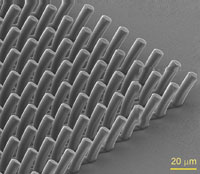Keep up-to-date with all the latest news from Soft Matter! Follow us @softmatter to find out our latest Hot articles, themed issues, news from the journal and much more!
Sticky materials from bent pillars
Materials resembling a gecko’s hairy feet could lead to smart adhesives or microrobots capable of climbing walls claim South Korean and US scientists.
Asymmetric adhesion is used by many insects and gecko lizards, allowing them to move on nearly any surface – horizontal, tilted or vertical. Many of these creatures have feet covered by intricate fibrillar structures that are responsible for their superb climbing ability. Among these creatures, gecko lizards have one of the most efficient and interesting adhesion devices consisting of finely angled arrays of branched fibres (setae).
Now a team led by Ho-Young Kim at Seoul National University, South Korea, and Ashkan Vaziri at Northeastern University, Massachusetts, US, has created an array of tilted polymer pillars to form a surface with asymmetric adhesion and friction properties similar to a gecko’s footpad. An arrangement of straight polymer micropillars is created using soft lithography and then exposed to an argon ion beam. The ion beam causes the surface of the micropillars to wrinkle which uniformly bends the pillars towards the ion beam – forming a tilted array.
‘A key feature of natural fibrillar interfaces is that properties such as friction and adhesion depend quite strongly on the direction of testing,’ explains Anand Jagota an expert in the mechanics of soft materials at Lehigh University, Pennsylvania, US. ‘One important reason is that the underlying fibrils are bent,’ he adds. Shu Yang an expert in biomimetic materials at the University of Pennsylvania in the US welcomes the research saying, ’tilted pillars as observed in gecko foot pads have often eluded us because of the complexity in fabrication and our inability to control the tilting angles. This is a novel and simple approach to create titled polymer pillars in a controlled fashion.’ The polymer micropillars don’t yet have the hierarchical structure found on a gecko’s setae. This is something the team hope to replicate in the future although they also have grander plans. ‘We’d like to work with other collaborators to create microrobots that use the tilted micropillars to climb walls’ says Ashkan Vaziri, ‘as well as improving the surface properties of the material.’
Tilted Janus polymer pillars
Myoung-Woon Moon, Tae-Gon Cha, Kwang-Ryeol Lee, Ashkan Vaziri and Ho-Young Kim, Soft Matter, 2010
DOI: 10.1039/c0sm00126k











